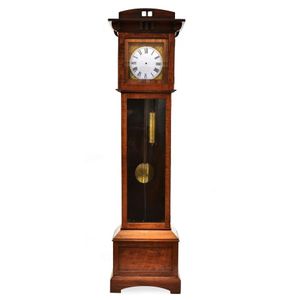George III Mahogany Grandfather Clock, c. 1910
You must be a subscriber, and be logged in to view price and dealer details.
Subscribe Now to view actual auction price for this item
When you subscribe, you have the option of setting the currency in which to display prices to $Au, $US, $NZ or Stg.
- Mahogany - Mahogany is a dense, close grained red-coloured timber from the West Indies and Central America. It was first imported into Europe in the the early 18th century and its use continued through the 19th century. It was popular for furniture making because of its strength, the wide boards available, the distinctive grain on some boards, termed flame mahogany and the rich warm colour of the timber when it was polished.. The "flame" was produced where a limb grew out from the trunk of the tree, and this timber was usually sliced into veneers for feature panels on doors, backs and cornices.
Some terms used to describe mahogany relate to the country from which it originally came, such as "Cuban" mahogany, "Honduras" mahogany etc. However unless the wood has been tested the names assigned are more a selling feature, rather than a true indication of the timber's origin. - Maple - Maple, native to North America, is a dense heavy timber from light to yellow-brown in colour. It has very little distincive graining unless it is one of the variants such as birds-eye maple or burr maple, so was not used extensively for furniture in 18th and 19th century, where cabinetmakers and designers preferred timbers with more distinctive features such as mahogany, walnut, rosewood and oak.
Birds-eye maple has a seres of small spots linked by undulating lines in the grain, is highly sough and is used as a decorative veneer. Burr maple has larger and irregular grain swirls than birds-eye maple. - George Iii - George III (1738 - 1820) was King of Great Britain and Ireland from 1760 to 1820.
- Pendulum - The pendulum was discovered around 1602 by Galileo Galilei, and was adopted for time keeping by the Dutch mathematician and natural philosopher, Christiaan Huygens, who excelled in astronomy, physics, and horology.
The pendulum comprises a metal rod usually of brass or steel with a metal disk, known as a bob, at the end. The movement of the pendulum is driven by weights or a spring, and as a pendulum swings in a regular arc, it was found accuracy could be controlled to within a few seconds a week.
Timekeeping can be adjusted by changing the height of the bob on the rod, making the pendulum either swing slower or faster.
The disadvantage of the pendulum was that changes in temperature also changed the length of the pendulum, interfering with the accuracy of the clock, and so in the 18th century two types of mercurial pendulums were invented which countered the movement in the steel rod.
The pendulum was the world's most accurate timekeeping technology until the invention of the quartz clock, regulated by a quartz crystal, in 1927.
This item has been included into following indexes:
Visually similar items

A mahogany long case clock, English, John Ellicott, London, 8-day movement with deadbeat escapement and rack strike, brass dial, strike/silent in arch, silvered chapter rings, Roman numerals, calendar aperture, subsidiary seconds dial, rococo spandrels, th

A Victorian mahogany eight-day longcase clock, maker Probert Wigan, the hood with swan neck pediment, and flanked by turned pillars with a dial painted with flowers and subsidiary second dial, the trunk banded with rosewood, enclosed by a panel door on bra

A longcase clock with a fiddleback blackwood case, the Arts & Crafts inspired case, with a rectangular glazed door enclosing a circular dial with Roman numerals, (dial hands loose) 197 cm high

A longcase regulator clock in Regency style mahognay case with bevelled glass fronted door. The movement of massive construction with deadbeat anchor escapement and brass weight. Wood rod pendulum with brass faced bob. Round silver dial signed, Thwaites an
